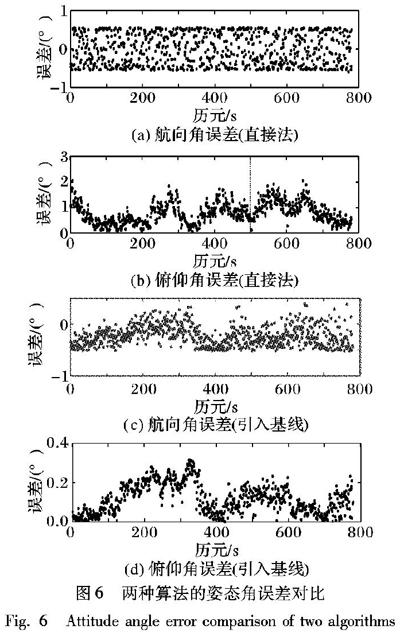基于低成本接收机的双天线测姿算法
2019-10-23王守华李云柯孙希延纪元法
王守华 李云柯 孙希延 纪元法



摘 要:针对低成本接收机双天线测姿系统利用直接法解算精度较低且存在系统粗差的问题,提出一种基于载波和伪距双差实时动态定位(RTK)卡尔曼滤波算法。首先,引入基线长度作为观测量,并将事先测量得到的精确基线长度作为观测量误差;然后,根据从天线接收机的历元时间间隔对主天线位置进行实时矫正,而周整模糊度采用改进LABMDA算法求解。在静态和动态情况下进行了测试,结果表明,在基线长度为1.1m、采用GPS和北斗双系统进行观测的情况下,所提算法解算出的航向角精度在1°左右,俯仰角精度在2°~3°。相比传统的双天线直接法测姿,该算法在系统抗差性能和精度上都较优。
关键词:双天线测姿;低成本接收机;卡尔曼滤波;基线约束;实时动态定位
中图分类号: TN967.1
文献标志码:A
Dual-antenna attitude determination algorithm based on low-cost receiver
WANG Shouhua1,2*, LI Yunke1,2, SUN Xiyan1,2, JI Yuanfa1,2
1.Guangxi Key Laboratory of Satellite Navigation and Location Awareness (Guilin University of Electronic Technology), Guilin Guangxi 541004, China ;
2.National and Local Joint Engineering Research Center of Satellite Navigation and Location Awareness, Guilin Guangxi 541004, China
Abstract: Concerning the problem that low-cost Dual-antenna Attitude determination System (DAS) has low accuracy and gross error because of using direct solution, an improved algorithm based on carrier phase and pseudo-range double-difference Real-Time Kinematic (RTK) Kalman filter was proposed. Firstly, the baseline length was employed as the observation, then the precise baseline length obtained in advance was taken as the observation error. Secondly, the position of master antenna was corrected according to the epoch time interval of the slave antenna receiver and the integer ambiguity was solved by MLABMDA (Modified LABMDA) algorithm. Experimental results in static and dynamic mode show that the accuracy of the heading angle calculated by the proposed algorithm is about 1 degree and the calculated pitch angle accuracy is about 2-3 degrees in the case of baseline length 1.1m with GPS and Beidou dual systems. The proposed algorithm improves the robustness and accuracy of the system greatly compared with the traditional dual-antenna attitude determination by direct solution.
Key words: dual-antenna attitude determination; low-cost receiver; Kalman filter; baseline constraint; Real Time Kinematic (RTK)
0 引言
全球衛星导航系统(Global Navigation Satellite System, GNSS)技术在定位、导航和测绘领域有着众多的应用,姿态测量就是其中之一,它可以实时提供低速载体的姿态信息,利用双天线可以测量出载体的航向角和俯仰角,对于船舶、车辆等载体有着实际的应用价值。相比惯性导航系统,天线测姿系统所产生的误差不会随时间积累,具有成本低、维护简单、功耗小的优点,然而受限于测量方法,系统精度与精密惯导系统相比还存在一定差距,且不适用于高速动态和信号遮挡的场景。目前天线测姿解算方法主要有三种:基于矢量观测法、基于最优估计法和直接矩阵法[1],其中直接法算法实现容易,对硬件平台要求较低,且计算精度也能满足实际需求[2];从天线布局上有立体布局和平面布局[3],双天线测姿属于平面布局。
用基线参数来解算姿态角时,需要得到毫米级的基线向量,天线之间的基线向量采用实时动态定位(Real Time Kinematic, RTK)解算算法,该方法运用载波伪距双差和周整模糊度解算技术来获取天线之间精确的基线解[4]。另一种方法是通过姿态参数组合或四元数法,将姿态角引入到GNSS观测方程中来求解[5];但是该方法在观测方程中并没有用到基线约束条件,而且引入四元数后,算法复杂度大大增加。文献[6]和文献[7]采用多天线接收机解决了钟差所带来的影响,解算精度较高;但是多天线接收机成本较高,不宜普及。文献[8]使用传感器融合技术对载体姿态进行求解,该方法使用磁力计、加速度计、陀螺仪等传感器,通过多级滤波器融合进行解算,在精度和抗干扰性能上较好;但是传感器的使用引入了更多的系统误差,而且使用精度越高的传感器相应成本也越高。
